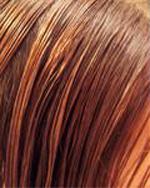|
Gentlemen prefer blondes... but gentlemen marry brunettes. Anita Loos |
Why people lose hair?
The healthy condition of the hair depends, to a very large extent, on the intake of sufficient amounts of essential nutrients in the daily diet. Hair is made of keratin, a protein, which also makes up the nails and the outer layer of our skin. One of the primary cause of hair loss is a high amount of the male hormone, dihydrotestosterone (DHT) within the hair follicle. DHT is produced from testosterone in the prostate, various adrenal glands, and the scalp. After a period of time, an over abundance of DHT causes the hair follicle to degrade and shortens the active phase of the hair. Women require 60 grams, men 80 to 90 grams, adolescent boys and girls 80 to 100 grams of protein. It is supplied by milk, buttermilk, yogurt, soyabean, eggs, cheese, meat and fish. A deficiency of some of the B vitamins, of iron, copper and iodine may cause hair disorders like falling of hair and premature greying of hair. There are many surgical procedures which will help to restore the hair from falling. Surgical restoration is the only permanent solution to baldness. It involves a series of operations that extract plugs of scalp from the sides and back of your head, where hair grows densely, and implant them on top and in front, where you are going bald. Scalp reduction is performed on patients with well-defined bald spots in the crown area of the scalp. It is sometimes done in conjunction with hair transplantaion to reduce the size of the bald scalp, especially in patients who do not have enough donor hair to cover the bald areas. Male pattern baldness that is the condition responsible for over 98% of all hair loss in men. It gets its name from the pattern of hair loss, which ultimately results in a horseshoe of hair that resides on the sides and back of the head, while the top of the head is completely bald. Some men begin MPB by losing the hair in their hairline. Others start in the crown. The chief difference in womens androgenic hair loss from mens (both are hormone related) is that women tend to experience thinning that occurs in no particular pattern or part of the scalp. Unlike men, the scalp may not actually be totally denuded of hair, just thin to the point where the scalp is visible. Like men, however, the resulting hair loss is generally irreversible. New hair resulting from minoxidil use may be thinner and shorter than previous hair. But there can be enough regrowth for some people to hide their bald spots and have it blend with existing hair. New hair stops growing soon after you discontinue the use of minoxidil. If you experience minimal results within six months, your doctor may recommend discontinuing use. Side effects can include irritation of the scalp. Finasteride is not approved for use by women. In fact, it poses significant danger to women of childbearing age. If you're a pregnant woman, don't even handle crushed or broken finasteride tablets because absorption of the drug may cause serious birth defects in male fetuses. Anthralin (Drithocreme). Available as either a cream or an ointment, anthralin is a synthetic, tarry substance that you apply to your scalp and wash off daily. It's typically used to treat psoriasis, but doctors can prescribe it to treat other skin conditions. Anthralin may stimulate new hair growth for cases of alopecia areata. Most people require more than one session, each spaced at least six months apart each to complete the hair restoration in an area. The timing and number of transplants depends on the amount of hair you have when you start, how much is anticipated that you will continue to lose without transplanting and how much hair density you desire. In the hands of well-trained and experienced physicians, and using newer techniques with smaller grafts, the hair grows in the proper direction with a feathered hairline, and a highly aesthetic result. The site from where the hair is taken is usually a fine scar line which is hidden by the permanent hair in that area. After the procedure there are tiny marks where the grafts have been placed. Initially there is some crusting over these areas (5-14 days) but after this, these areas are usually not detectable. In most cases, immediately after the hair transplant the hairs fall out of the grafts, and do not regrow for 1-3 months. After this they begin to grow as normal hair. With each session there is more hair, and the resulting appearance is thicker hair. Women with localized thinning on the top of their heads or thinning around the temples often make good candidates for hair transplantation. Prior to evaluation for hair transplantation, it is important for women to discuss your thinning hair with a dermatologist and/or endocrinologist to make sure there is no other treatable reason for the hair loss. Hair transplantation is a cost-competitive solution for hair loss. Other hair replacement alternatives require additional maintenance over the years. The cost depends on the amount of bald area that will need to be transplanted, and the desired thickness. More grafts are necessary to cover more bald or thin area and to maximize hair density. Because the procedure is individual, costs are usually determined individually. Hair transplantation is universally accepted as a treatment for hair loss. While it was developed and first offered as a hair-loss treatment for men, women have increasingly found hair transplantation a viable option to correct the cosmetic deficit of thinning hair. Advances in hair transplantation techniques and better understanding of the biology of female hair loss contributed to the evolution of hair transplantation got women. Alopecia Areata Childbirth - When a women is pregnant, more of her hairs will be growing. However, after a woman delivers her baby, many hairs enter the resting phase of the hair cycle. Within two to three months, some women will notice large amounts of hair coming out in their brushes and combs. This can last one to six months, but resolves completely in most cases. Inadequate Protein in Diet - Some people who go on crash diets that are low in protein, or have severely abnormal eating habits, may develop protein malnutrition. The body will save protein by shifting growing hairs into the resting phase. Massive hair shedding can occur two to three months later. Hair can then be pulled out by the roots fairly easily. This condition can be reversed and prevented by eating the proper amount of protein and, when dieting, maintaining adequate protein intake. Birth Control Pills - Women who lose hair while taking birth control pills usually have an inherited tendency for hair thinning. If hair thinning occurs, a woman can consult her gynecologist about switching to another birth control pill. When a women stops using oral contraceptives, she may notice that her hair begins shedding two or three months later. This may continue for six months when it usually stops. This is similar to hair loss after the birth of a child. See products which may help hair loss. Low Serum Iron - Iron deficiency occasionally produces hair loss. Some people don't have enough iron in their diets or may not fully absorb iron. Women who have heavy menstrual periods may develop iron deficiency. Low iron can be detected by laboratory tests and can be corrected by taking iron pills. Major Surgery/Chronic Illness - Anyone who has a major operation may notice increased hair shedding within one to three months afterwards. The condition reverses itself within a few months but people who have a severe chronic illness may shed hair indefinitely. Fungus Infection (Ringworm) of the Scalp - Caused by a fungus infection, ringworm (which has nothing to do with worms) begins with small patches of scaling that can spread and result in broken hair, redness, swelling, and even oozing. This contagious disease is most common in children and oral medication will cure it. Physical and emotional stress might cause hair loss since body is recuperating from an overwhelming turmoil and simply shuts down hair production, thinking that it is not necessary for the body's survival, thereby contributing all energy toward repairing vital body parts. there can be up to three months delay between the major incidence and the actual hair loss. Moreover, there is also period of three months before the loss hair is replaced. This then means there is a total of a minimal of 6 moths for the total hair loss and regrowth cycle. Of course there are things that might contribute to hair loss such as anemia, low blood count, and thyroid abnormalities. Hair is composed of Keratin, a special protein that also produces our fingernails and toenails the nails and forms the protective outer layer of our skin. Each strand of hair consists of three concentric layers, the cuticle, the cortex and the medulla. The outer layer is called the cuticle and is thin and colorless, its job is to protect the thicker cortex which contains the melanin. Melanin is responsible for the color of your hair and the actual color depends on what kind of melanin you have . There are two kinds, eumelanin which creates brown or black hair, and pheomelanin which makes hair appear red. Blonde hair is a result of very low amounts of melanin, the shade of the blonde again depends upon which type of melanin you have. Gray hair is a result of a lack of melanin which is often caused by age but can also be caused by stress and illness. The average Caucasian person has 5 million hairs of which 100,000 - 150,000 are on the head. Blondes not only have more fun, they also have more hair, about 140,000 more than average, Brunettes have slightly higher than average hair about 105,000 hairs, and redheads have a little less than average about 90,000 hairs.
DefinitionsScalp Health tips and advises for everybody.
|

